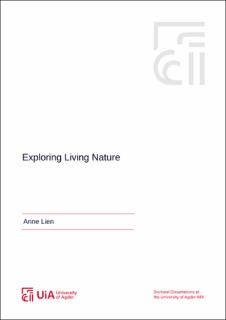| dc.description.abstract | The purpose of this study is to phenomenologically explore the practices of observing living nature in history, teaching, and learning, and to discuss potentials and constraints with teaching and learning observational practices in primary school. The main research question is: What is the nature and meaning of observing living nature in science education in primary school? In my experience the study of biology requires careful observation, but research show that the process of observation is often underestimated in science teaching and learning or taken for granted or even ignored. In all sciences, observational practices are of fundamental importance but still, these practices seem to be a blind spot in school. In addition, research reports of an ongoing massive loss of species and nature, an ongoing loss of knowledge about nature, and a seemingly parallel ongoing loss of attention in terms of what several studies describe as a blindness to nature.
The research design of my PhD-project has three phases: Phase 1 prepare four teaching cases from the history of science that demonstrate complementary modes of observing living nature, Phase 2 implements the four cases in a course for teachers in primary school, and Phase 3 explores how the teachers implement the cases in school. Phases two and three are both related to the same case study where the unit of inquiry is a case with five teachers and their students in fifth grade in primary school. In the case study, my investigations have a phenomenological approach with the purpose to examine the students and teachers’ lived experiences with observing living nature. I have made classroom observations, collected notes and reflection logs, and conducted interviews with both teachers and students.
In Phase 1, my analysis leads to a typology of four modes of observation: Case I about Aristotle demonstrates a comparative mode of observation. Case II about Maria Sibylla Merian demonstrates a holistic and aesthetical mode of observation. Case III about Carl von Linné demonstrates an analytical and systemic mode of observation. Case IV about Alfred Russell Wallace and Charles Darwin demonstrates an explanatory and synthetical mode of observation. I further apply an analysis to design and prepare the cases for teaching, and I summarize the analysis in a general structure for designing teaching cases.
In phases two and three, my phenomenological analysis of the interviews with both teachers and students, suggests eight themes that describe essential aspects of their experiences with observing living nature. The themes specify, among other things, how observation has an ontological meaning by bringing out the things in the world of the students and teachers, the interplay between learning observational skills and other skills, how practicing observation might change the role of the teacher, and the complexity in describing and understanding scientific observational practices for both teachers and students. The results of the analysis show that the teachers and students have different perceptions of what matter in practicing observation of living nature that sometimes challenge each other. My findings suggest that teaching observational practices that invite the students to pay attention and respond to what living nature presents to them, may be an alternative to teaching as telling the students what to look for. The criteria for what matter in an observation are not given and what kind of skills the students practice may change their perception of what is relevant to observe. The question is not only what kind of knowledge the students get when practicing different modes of observation, but how both the ‘things’ in living nature and the students come into being through these practices.
Implications of my findings from all the three phases point to two issues that I explore further in the last part of this thesis: (i) Ethical attention in observational practices. In a model I suggest conditions for practicing an ethical attention in the triangle of teacher, student, and phenomena in living nature. In teaching, the model can support the teacher in considering what is valuable, good, or important, to pay attention to in nature, and how the students can be invited to explore those phenomena in nature in responsible ways. (ii) Conditions for more sensible observational practices in primary school. By sensible observational practices I mean observational practices that are contextualized within the students’ familiar world, and that emphasize students’ sensuous, embodied experiences and emotional involvement in these practices. I present two models as a basis to discuss the relationship between the students, the phenomena in living nature, and (scientific) representations in science teaching and learning. The first model show how (scientific) representations may become a wedge between the students and the phenomena in living nature under certain conditions, instead of bringing them together. The second model is a development of the first and illustrates observational practices as dynamic processes where the phenomena in living nature and the students are brought together, and where scientific representations may develop from the students’ own experiences and induce an opening to new experiences.
Finally, I point towards a fifth teaching case which suggest a mode of observation that complements an anthropocentric perspective. Case V describes a participatory and empathetic mode of observation to investigate multiple meaning-making processes, a mode of observation that invites the students to identify themselves with other living beings in a very concrete and fundamental way. | |

